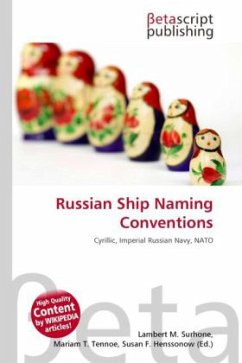
Russian Ship Naming Conventions
Versandkostenfrei!
Versandfertig in 6-10 Tagen
26,99 €
inkl. MwSt.

PAYBACK Punkte
13 °P sammeln!
High Quality Content by WIKIPEDIA articles! The Russian and Soviet Navy's naming conventions were similar to those of other Nations. A problem for the non-Russian reader is the need to transliterate the Cyrillic names into the Latin alphabet. There are often several different Latin spellings of the same Russian name. Cyrillic script is an alphabet developed in the 9th century in Bulgaria, and used in the Slavic national languages of Belarusian, Bulgarian, Russian, Rusyn, Serbian, Macedonian, Montenegrin and Ukrainian, and in the non-Slavic languages of Moldovan, Kazakh, Uzbek, Kyrgyz, Tajik, T...
High Quality Content by WIKIPEDIA articles! The Russian and Soviet Navy's naming conventions were similar to those of other Nations. A problem for the non-Russian reader is the need to transliterate the Cyrillic names into the Latin alphabet. There are often several different Latin spellings of the same Russian name. Cyrillic script is an alphabet developed in the 9th century in Bulgaria, and used in the Slavic national languages of Belarusian, Bulgarian, Russian, Rusyn, Serbian, Macedonian, Montenegrin and Ukrainian, and in the non-Slavic languages of Moldovan, Kazakh, Uzbek, Kyrgyz, Tajik, Tuvan, and Mongolian. It also was used in past languages of Eastern Europe, the Caucasus, and Siberia. The Cyrillic alphabet is also known as azbuka, derived from the old names of the first two letters of most variant Cyrillic alphabets. Since the accession of Bulgaria to the European Union on 1 January 2007, Cyrillic became the third official alphabet of the European Union, following the Latin and Greek alphabets.












